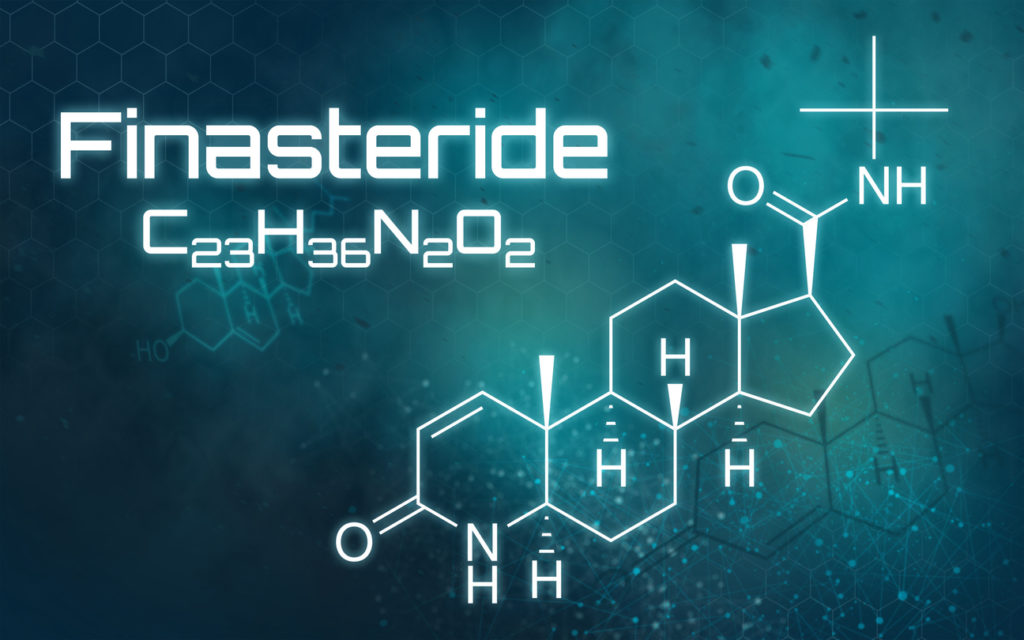Contaminated FinPlus and Medical Resources on Minoxidil Toxicity

Chemical formula of Finasteride
On May 12, 2020, MasterPharm, a compounding pharmacy based in New York, issued a recall of its popular hair regrowth formulation FinPlus. This medication, compounded by MasterPharm by prescription from a physician, includes finasteride 1.25 mg and a combination of Biotin, L-Lysine, Zinc, and riboflavin (vitamin B2) that are used to treat hair loss in men and women.
Finasteride is the same active ingredient utilized in Propecia, an FDA approved drug for hair regrowth and male pattern baldness (or androgenetic alopecia), which has been marketed since 1992. It is also the same active ingredient (although at a higher dose) utilized in Proscar, a medication used to treat an enlarged prostate gland (also known as benign prostatic hyperplasic or BPH). Finasteride is a 5-alpha reductase inhibitor involved in blocking the body’s processing of testosterone into dihydrotestosterone (DHT).
FinPlus is not technically FDA-approved, but the prescription of compounded medications is common and generally safe for most patients. The recall of the compounded Finasteride sold by MasterPharm was reportedly initiated after independent laboratory testing showed that no finasteride was included in the tested capsules and that they instead contained toxic levels of minoxidil. The testing results indicated that the level of minoxidil, which is not a part of the FinPlus formulation, was 147.7 mg. It is believed that the contaminated FinPlus was ingested by 70 patients in South Florida, and nearly ½ of those patients have reported symptoms consistent with minoxidil toxicity to MasterPharm.
Minoxidil is a smooth muscle vasodilator initially created in the 1950s and used widely for decades thereafter to treat hypertension or elevated blood pressure. The drug relaxes and widens the blood vessels which improves blood flow. Due to the severity of side effects with the medication and the availability of other blood pressure medications, minoxidil is, today, primarily used only when other therapies for severe hypertension have failed. In the 1980s, there was an incidental finding that the drug appeared to stimulate hair growth. In 1986, minoxidil was approved for use by hair loss patients, and the brand name version of the drug (as a topical pharmaceutical) was marketed as Rogaine. Side effects (with even normal doses of minoxidil) can include dizziness, pericardial effusion progressing to cardiac tamponade (excess fluid around the heart), tachycardia, hypotension, and worsening of chest pain or angina pectoris.
In several animal studies, cardiovascular lesions (including necrosis of the papillary muscle and subendocardial areas of the left ventricle; hemorrhagic lesions; epicarditis; and cardiac hypertrophy and dilation) were noted in animals given significant doses of minoxidil. Overdoses of minoxidil in humans has been noted in the medical literature to cause pericardial effusion, prolonged hypotension (life-threatening low blood pressure), or unstable angina. Many of these same symptoms consistent with minoxidil toxicity have been noted by patients that ingested contaminated FinPlus compounded finasteride medications manufactured by MasterPharm. Unfortunately, the lack of significant medical experience with treating minoxidil overdose patients has led to uncertainty about whether (and to what extent) these patients might have sustained long-term damages.
Additional scientific and medical resources on minoxidil toxicity:
Cardiovascular Toxicity of Minoxidil in the Marmoset (August 2008) – French scientists noted myocardial necrosis in the left and right ventricles, papillary muscles, right and left atrium, and septum as well as arteriopathy in small coronary vessels in monkeys exposed to high doses of minoxidil and these results were believed to be due to the effects of the drugs of blood pressure rather than directly causing the cardiac damage.
The Pharmacologic Basis of the Cardiovascular Toxicity in the Dog (July 1995) – Study published by researchers from Upjohn Laboratories that found that the heart damage noted in the study appeared to be due to the effects of minoxidil on blood flow rather than the drug causing direct damage to the heart structures.
Minoxidil Associated Pericardial Effusion: A Case Report (2015) – Report of a patient that developed pericardial effusion (a fluid collection around the heart) shortly after restarting minoxidil. The case report notes that the patient had pre-existing kidney disease, which (along with heart failure) makes patients potentially more susceptible to developing drug-induced pericardial effusion.
Unstable Angina: A Rare Presentation of Minoxidil Intoxication: A Case Report and Literature Review (2018) – Report of patient that accidentally ingested minoxidil liquid and was seen in an Iranian emergency room with severe chest pain, low blood pressure, agitation, and had EKG abnormalities and recovered after 4 days of treatment.
Share This


